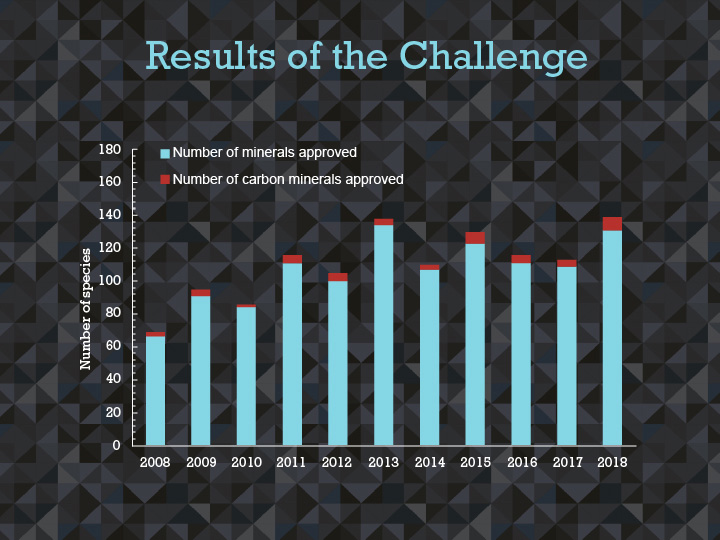The Carbon Mineral Challenge: A look back at a four-year experiment in big data mineralogy
20 November 2019
The Carbon Mineral Challenge ended its four-year run in September 2019 with 31 new carbon minerals.
Launched at the 2015 AGU Fall Meeting, the Challenge built on the work of Deep Carbon Observatory (DCO) Executive Director Robert Hazen (Carnegie Institution for Science, USA) and colleagues, who use data science and statistical methods to look at the known minerals on Earth and predict those that should exist but remained undocumented.
Study co-author and Carbon Mineral Challenge lead Daniel Hummer summarized the findings an article he authored in The Australian Journal of Mineralogy and in a presentation at the 2019 meeting of the Geological Association of America. In the end, 31 new carbon-bearing mineral species were verified.

The proportion of new carbon-bearing minerals increased from an average of 3.6% before to an average of 5.0% during the Challenge, which represented a statistically significant increase in the rate of discovery.

Here are some mineral highlights from the Carbon Mineral Challenge:
- Abellaite was the first new carbon mineral ratified during the Challenge and was predicted by Hazen and colleagues.
- Tinnunculite is an organic mineral composed of uric acid and forms when droppings from a European kestrel. A collector in New Hampshire, Tom Mortimer, found a second locality for tinnunculite.
- Middlebackite is named for the quarry’s home, the Middleback Range in Australia, where another 163 minerals have been identified, 17 of them containing carbon.
- Leószilárdite is a rare, ephemeral, and water-soluble uranyl carbonate mineral.
- Ewingite is a uranyl carbonate mineral that now holds the record for the most structurally complex mineral on Earth.
- Parisite-(La) is another mineral with chemistry predicted by Hazen and colleagues.
- Markeyite is among more than 30 new minerals discovered in several uranium mines in Red Canyon.
- Stracherite is the first carbonate-bearing member of the very rare nabimusaite mineral group.
- Ramazzoite is the first mineral found in nature that contains a polyoxometalate cation.
- Phoxite is the only mineral that contains both phosphate (ph) and oxalate (ox) groups as essential constituents.
- Davidbrownite-(NH4), tinnunculite, triazolite, marchettiite all contain molecules with biological origins that can be traced to the urine or feces of a bird or other animal.
- Uroxite and metauroxite are the first two uranyl-oxalate minerals.
- Edscottite is an iron carbide found in the Wedderburn meteorite. A group in South Africa is following up on additional new carbide minerals in a Sarahan meteorite.

